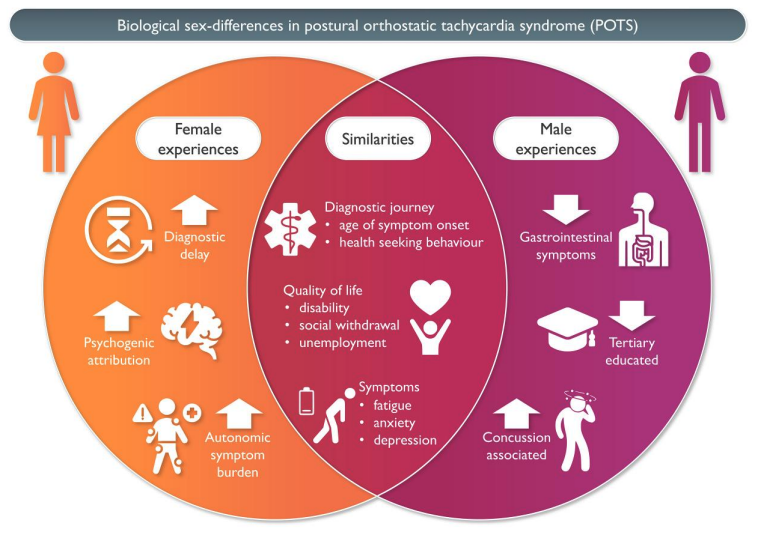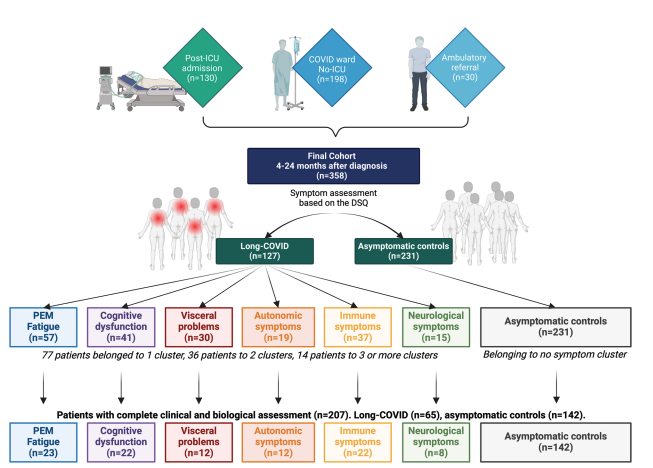This month’s Research Digest highlights new studies advancing our understanding of ME/CFS, long COVID, and related conditions. An Australian POTS study reveals that women experience more severe symptoms and longer diagnostic delays than men. A long COVID Belgian study links severe fatigue symptoms with signs of accelerated ageing and cardiac involvement, while a Harvard-led analysis of severely ill ME/CFS patients, identifies unique gene patterns supporting its classification as a neuroimmune disease. We also feature a powerful personal piece by journalist Zoe Simmons, advocating for greater visibility and support for those living with chronic illness and disability.
Contributing Digesters: Sarah, Jyothsna, Shan and Simone.
We hope you enjoy the Easy Read Overview and audio summary we’ve included under each article’s title – it’s now even easier to stay informed of the latest ME/CFS and long COVID research!
You can join our community by signing up here to our mailing list and receiving the Digest straight to your inbox at the end of every month. We appreciate the support of everyone who reads the Digest – we encourage regular subscribers to support us with a monthly suggested donation of $2.
Biological sex-dependent differences in postural orthostatic tachycardia syndrome
Authors: Seeley M-C, Wilson G, Ong E, Langdon A, Chieng J, Bailey D … & Gallagher C (The University of Adelaide, Australia)
Publication: European Journal of Cardiovascular Nursing (Mar 2025).
Link: https://academic.oup.com/eurjcn/advance-article/doi/10.1093/eurjcn/zvaf048/8095354?login=false
Easy Read Overview: Postural orthostatic tachycardia syndrome (POTS) affects the autonomic nervous system and causes symptoms when people stand up. It is more common in young women and often comes with other health problems. This study looked at differences between men and women with POTS in Australia. It found that women had more severe symptoms and waited longer to be diagnosed, often having their symptoms blamed on mental health issues. The researchers think these differences may be due to how doctors respond to male and female patients.
Postural orthostatic tachycardia syndrome (POTS) is an autonomic nervous system disorder causing heightened sympathetic responses to change in posture. It is commonly seen in young women, frequently presenting in combination with complex multi-morbid conditions. This study sought to identify sex-based differences in symptoms and diagnosis of POTS through a prospective, cross-sectional study.
This study included 500 participants (452 females and 48 males) aged 16 years and older from the Australian POTS registry. All participants had a physician-confirmed POTS diagnosis. Health-related quality of life was assessed via a questionnaire. Self-reported socio-demographics and diagnostic journey were recorded. The composite autonomic symptom score was used to assess autonomic symptom burden.
The authors found that females experienced worse autonomic symptom burden compared to males. Although both sexes interacted with similar numbers of doctors and hospitals/emergency departments before diagnosis, females experienced longer diagnostic delays than men (average of 7 years compared to 3.8 years). Females were also 1.27 times more likely to experience a diagnostic delay of greater than 10 years. Females were also more likely than males to have their symptoms attributed to anxiety or depression, and given a mental health treatment plan. In spite of the delayed diagnosis and worse symptom burden, females reported similar anxiety, depression and health related quality of life to males.
The authors conclude that females and males experience significant differences in diagnostic delay and symptom burden from POTS. These differences did not appear to be the result of different symptom reporting or health-seeking behaviour, but to be the result of clinician-dependent factors. The authors propose that further research is needed to further explore clinician attitudes in the diagnosis and treatment of POTS for men and women.

Figure: Biological sex differences in postural orthostatic tachycardia syndrome (POTS).
The figure illustrates that women are more likely to experience delayed diagnosis, have their symptoms attributed to psychological causes, and report a greater burden of autonomic symptoms. In contrast, men report fewer gastrointestinal symptoms, are less likely to be tertiary educated, and their symptoms are more likely to be associated with a history of concussion. Both sexes report similarities in symptoms like fatigue and depression, impact of symptoms on quality of life, and a shared diagnostic journey.
Tetrahydrobiopterin in myalgic Exploring DNA methylation, telomere length, mitochondrial DNA, and immune function in patients with Long‑COVID
Authors: Polli A, Godderis L, Martens DS, Patil MS, Hendrix J, Wyns A … & Lorent N (Katholieke Universiteit Leuven, Belgium)
Publication:BMC Medicine (Feb 2025)
Link: https://bmcmedicine.biomedcentral.com/counter/pdf/10.1186/s12916-025-03881-x.pdf
Easy Read Overview: This study looked at why some people have long-term symptoms after COVID-19. Researchers followed 358 adults and grouped their symptoms into six types, including fatigue, thinking problems, and pain. People with severe post-exertional malaise and fatigue had signs of faster ageing in their cells and possible heart problems. However, overall, there were no big differences in inflammation or other blood markers between people with long COVID and those who had recovered from COVID-19. The authors suggest future research should focus on studying subgroups to better understand the condition.
This study explored potential biological mechanisms underlying long COVID, including telomere length, mitochondrial DNA content (mtDNAcn), global DNA methylation, cytokine expression, and blood markers, to better understand its pathophysiology.
This study included a prospective cohort of 358 adults who were diagnosed with COVID-19 between March 2020 and March 2022. The sample included 328 patients who had been hospitalised with COVID-19 (130 requiring intensive care admission), and 30 ambulatory patients. Participants were followed up 4-12 months after initial infection and completed the modified DePaul Symptom Questionnaire (DSQ). 207 participants also agreed to undergo additional biological testing at follow up, and blood samples were collected from these participants.
Analysis of the DSQ identified six symptom clusters that persisted beyond two months: PEM-fatigue, cognitive dysfunction, autonomic dysfunction, visceral problems, neurological symptoms and immune disturbances. 127 participants exhibited moderate to severe symptoms in at least one cluster and were defined as having long COVID. 231 participants did not exhibit significant symptoms in any cluster, and were designated asymptomatic controls. More women than men were in the long COVID group. The time since infection and the severity of initial infection were not associated with the likelihood of ongoing symptoms. The PEM-fatigue cluster was the most prevalent (15.9%), and reflected hallmark ME/CFS symptoms such as post-exertional malaise, fatigue, sleep dysfunction, and pain.
While there were no significant differences in biological markers between the long COVID group as a whole and asymptomatic controls, subgroup analysis revealed differences between the PEM-fatigue group and controls. Participants in the PEM-fatigue cluster had significantly higher troponin T levels, shorter telomeres, and lower mtDNAcn compared to asymptomatic controls. These results suggest that cardiac issues and accelerated biological aging may be factors in long-COVID.
There were no significant group differences in inflammatory markers, including CRP and 14 cytokines, challenging the hypothesis that systemic inflammation is a driver of long-COVID.
The authors recommend that future research should focus on grouping long-COVID patients by symptoms to improve understanding. Additionally, research should investigate biological factors like cardiac involvement and telomere shortening as potential risk factors and identify specific targets for developing personalised treatments.

Figure: Flowchart summarising the study methodology, showing three groups (post-ICU admission, hospitalised, and ambulatory), each followed up 4-12 months post-infection. Based on the response to the DSQ, these groups were split into long COVID and asymptomatic controls. The analysis shows the differences in symptoms between the two groups.
A network medicine approach to investigating ME/CFS pathogenesis in severely ill patients: a pilot study
Authors: Hung L-Y, Wu C-S, Chang C-J, Li P, Hicks K, Dibble JJ, … Davis RW, Xiao W (Harvard Medical School, USA)
Publication: Frontiers in Human Neuroscience (Feb 2025)
Link: https://doi.org/10.3389/fnhum.2025.1509346
Easy Read Overview:About one in four people with ME/CFS are so sick they can’t leave their homes or are stuck in bed. This study looked at severely ill patients to better understand the biology behind ME/CFS. The researchers found gene changes linked to brain function, immune problems, hormone pathways, and viruses like COVID-19 and Epstein–Barr virus. These patterns were very different from those seen in depression, showing that ME/CFS is its own serious disease. The study supports the idea that ME/CFS is a neuroimmune disorder and may help lead to better treatments in the future.
Approximately a quarter of all ME/CFS patients are severely unwell, to the point of being housebound or bedridden. These authors used a network medicine approach to study severe ME/CFS patients, aiming to identify new disease modules to better understand the molecular mechanisms underlying the condition.
This study utilised the Severely Ill Patient Study (SIPS) cohort from the authors’ previous study, which contained 20 severely ill ME/CFS patients (International Consensus Criteria) and 10 healthy controls (HC). Whole genome sequencing (WGS) on blood samples from SIPS patients identified 96 likely pathogenic gene variants. Nine genes (ACADL, BRCA1, CFTR, COX10, HABP2, MFRP, PCLO, PRKN, and ZFPM2) were present in ≥10% of the patients, and of these, 77.8% have been linked with impaired cognitive or neurological function. These genes formed the basis of a “SIPS disease module”, which was then mapped onto a human protein–protein interaction (PPI) network.
Network medicine approaches were used to construct molecular networks to capture interactions between genes, proteins, and other biological elements. Analysis found a 3.94-fold enrichment of genes related to fatigue, a 2.29-fold enrichment of genes associated with cognitive disorders, as well as enrichment of 2.48-4.61 for genes that were associated with six specific neurodegenerative diseases: ALS, spinocerebellar ataxia, Huntington’s disease, Alzheimers disease, Parkinson’s, and prion disease.
These findings were then cross-referenced with disease modules created from ME/CFS gene set data from 23andMe and UK-Nor cohorts. These showed approximately 40% overlap with the SIPS module. Importantly, when the three ME/CFS disease modules were compared to the depression disease module, there was little overlap. The authors emphasise that this clear distinction highlights the importance of not mischaracterising ME/CFS as a form of depression. Instead, it should be recognised as a distinct neuroimmune disease.
Pathway analysis revealed associations between ME/CFS and COVID‑19, Epstein–Barr virus (EBV), antigen processing, various neurodegenerative diseases, and crucial cortisol synthesis/secretion pathways—supporting the hypothesis that ME/CFS is a neuroimmune disorder. Additionally, the identification of oestrogen-signalling pathways may help explain the higher prevalence of ME/CFS in females.
The authors propose that distinct genetic variants, clustered within network-defined modules, may underlie ME/CFS severity. These modules connect ME/CFS to immune activation, neurodegeneration, viral triggers, and endocrine dysfunction. The authors conclude that these findings support the characterisation of ME/CFS as a neuroimmune disorder and suggest potential avenues for targeted therapeutic interventions.
Fighting For Disability And ME/CFS Awareness
Authors: Simmons Z
Publication: Invacare (June 2025)
Link: https://www.invacare.com.au/support/news/fighting-disability-and-mecfs-awareness-–-zoe-simmons
In this article, Zoe Simmons, a disabled journalist and advocate, shares how she uses storytelling to challenge stereotypes and raise awareness of chronic illness. Despite the fact that around 20 percent of Australians live with disabilities, Zoe notes that their experiences are still underrepresented in the media, leadership and politics.
Zoe suspects she has mild ME/CFS and describes how even small tasks like leaving the house can lead to days of recovery. She points out that many medical professionals still do not recognise ME/CFS, either not believing patients or recommending harmful treatments like graded exercise.
Zoe shares her frustration in trying to publish her writing in mainstream media, despite the importance and urgency of the stories she tells. She argues this shows the need for more disability-led journalism and better support for disabled freelance writers. While she remains determined to keep speaking out, Zoe admits that constantly having to fight to be heard is exhausting.


